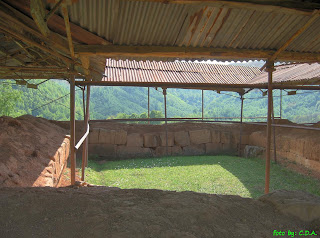In today's Orăştie Mountains (Şureanu Mountains), about 2000 years ago, during the time of Burebista and Decebalus and before the roman conquest, was the military, religious and political center of the Dacians. Built as a system of strongholds and fortifications, the place is unique in European architecture (for example the Murus Dacicus). Some of the most important Dacian fortresses found there, part of UNESCO World heritage are: Sarmizegetusa (Regia), Blidaru, Luncani-Piatra Roşie, Costeşti-Cetăţuia, Căpâlna and Baniţa. Due to time constraints I only managed to visit two of the fortifications.
Costeşti-Cetăţuia can be reached by car (on a short bumpy dirt road) from the village of Costeşti, while the remnants of Blidaru are 50 minutes away on foot starting from the village. Besides the citadel's heavily fortified walls there can be found, rather well preserved, two habitable towers and a sanctuary. Here's the location of Costeşti-Cetăţuie fortress on Google, and below are some of my photos:
Costeşti-Cetăţuia can be reached by car (on a short bumpy dirt road) from the village of Costeşti, while the remnants of Blidaru are 50 minutes away on foot starting from the village. Besides the citadel's heavily fortified walls there can be found, rather well preserved, two habitable towers and a sanctuary. Here's the location of Costeşti-Cetăţuie fortress on Google, and below are some of my photos:
In the natural reservation of Grădiştea Muncelului – Cioclovina, about 20km from Costeşti, driving on a dirt road (but still accessible even with a modest car) one can reach the Sarmizegetusa (also Sarmisegetusa, Sarmisegethusa, Sarmisegethuza, Ζαρμιζεγεθούσα (Zarmizegethousa), Ζερμιζεγεθούση (Zermizegethouse)) fortress, the capital of the Dacians during the rule of Decebalus - called Sarmizegetusa Regia (of the king) - situated at an altitude of 1200m. It's not to be confused with Ulpia Traiana Augusta Dacica Sarmizegetusa - the capital of the Roman Dacia, situated 40km away.
The fortress is a most moving place, covered in mystery and spirituality. There can be seen remnants of fortifications, roads and water pipes, but the most impressive are the religious temples and sanctuaries believed to be dedicated to the sun, which made many historians and archeologist to identify the Hill of Grădiştea with the holy mountain Kogaion. The most important landmarks are: the western and the eastern gates, the enclosure wall of the fortress, the paved road, the limestone sanctuaries, the circular sanctuaries, the andesite sanctuaries, the andesite sun (The Solar Disk - beeing either an ancient calendar or a place for sacrifices), the roman bath house and the observation tower. The location is this and some of my photos follow:
Some more pictures and information can be found here and here and especially from the Deva Museum of Dacian and Roman Civilisation .



























2 comments:
Hey, I'm trying to figure out how to go see these. What do you recommend? Hire a taxi in a nearby town? (I'm thinking Deva) Help woul dbe appreciated.
E-mail me james.goodwin (at) unb (dot) ca
That could be an idea, but i'm not sure if the taxi driver would want to take you on those bumpy roads. (and the nearest town that i guess has taxies is Oraștie, not Deva). Anyway, i guess it's going to be expensive (or you might just get double-crossed by the taxi driver to pay more). Probably best would be to rent a car (most probably in Deva or Alba-Iulia). One last option - hitchhiking - if you find some friendly drivers going that way and walking the rest of the way if you're more adventurous. Be careful that the locals in that area might not know English (or any other foreign language). One more thing - the last place with hostels (and occasional police) is Costești (from which you can walk to two of the fortresses but not Sarmizegetusa). From that point on it's only a "pseudo" - camping site (and rangers looking after the natural reservation).
Post a Comment